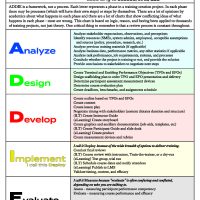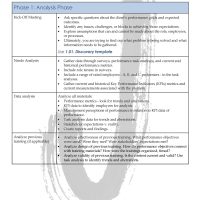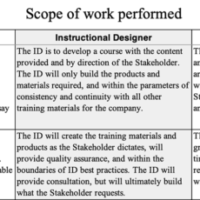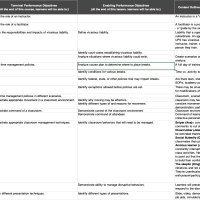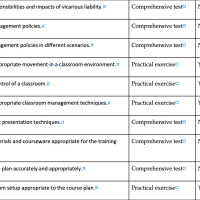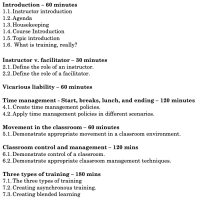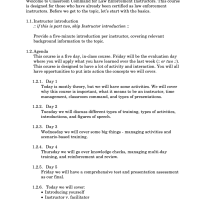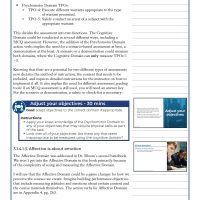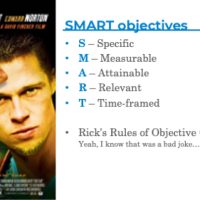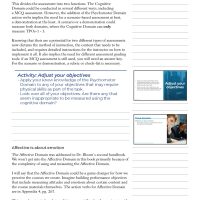This is the process we train in our 40-hour Instructional Design for Law Enforcement Instructors course and our smaller breakout classes for Advanced Training Development courses. It is also the process we use for creating training products for our clients.
Introduction
Quality of training has been increasingly the subject of liability lawsuits and it is only going to expand as litigators look for more opportunities to attack law enforcement. The problem is, there is case law and science that will support their claims. They believe they are holding police accountable.
To truly have accountability of personnel and instructors, training has to have consistency and continuity first. Consistency, continuity, and accountability are the ultimate goals for training and education. This can only be achieved by following a codified instructional design process – what we call the training chain of evidence.
This section will go through the process of creating a course of instruction using the system developed by Rick Jacobs for use in any learning environment, and which has been applied to military, law enforcement, and corporate training creation.
This process works for all modes of training – eLearning, Instructor-Led, hybrid, etc.
Analyze, Design, Develop, Implement, Evaluate
First, ADDIE is a framework, not a process.
The framework is designed to establish order and align processes and steps of course creation. There are many schools, programs, and teams that will claim they use ADDIE, but ultimately, they don’t. They typically Develop and Implement and that’s it. Even when they claim to follow ADDIE, they won’t have documented processes and steps to follow, leading to a lot of inconsistency in their training products, delivery, and results.
The process we use, and train law enforcement instructors to follow, is based on the phases of the ADDIE model. Just as investigating a case and developing the chain of evidence for that case, following consistent processes and steps makes for a stronger case.
This document lists the steps and processes applied within each ADDIE phase.
Phases of Course Creation
The Phases of Course Creation document goes into more detail about the different documents, steps, and processes used in creating training products. This becomes the direction for when and how the training product is created from concept to completion.
The document is especially useful when bringing new people onto a team. A team that has a documented process for creating training will be able to onboard new members faster and maintain consistency between training products developed individually.
Scope
This Scope of Work Performed Matrix was developed to determine the expectations and responsibilities for the instructional designer (ID), Subject Matter Expert (SME), and stakeholders. Expectations are what the “Instructional Designer” should have for Stakeholders and SMEs, and how the ID should expect to comport themselves during the project.
With every expectation, there are responsibilities. The matrix explains the expectation and requisite responsibility per scope of work performed for each role.
This is a tool for the ID to better understand what their role is, not a tool for SMEs or stakeholders to make decisions about an ID’s role. It helps the ID level-set with others and provide a clear line of expectations and responsibilities for all.
Analysis
Analysis is one of the most crucial parts of creating training, but it is also one of the most overlooked. Without analysis, training is entirely based off opinion, subjective experience, and anecdotal evidence.
Courts are becoming less willing to accept “experience, background, and training” as the explanation for why things are done a certain way. Instead, using learning science, training should be based off of “research, observation, and analysis.”
Your background is still essential – it is what you use to determine the veracity and accuracy of what is researched and observed. But, by placing it on research, observation, and analysis, you are using additional third-party evidence as the foundation instead.
Analysis includes researching and analyzing past training, case law, prior cases, academic research, and a performance task analysis. Analysis determines whether there is actually a training needed, and, if so, what the ultimate goals of the training should be – called performance outcomes.
All of this should be documented with citations and supporting documents, then turned into a report of your findings. Much like taking and completing an initial report for a case.
To use the metaphor of building a house, analysis is the research on what kind of house can be built and what issues you may run into. Home builders will do zoning research, environmental impacts, seasonal impacts, soil surveys, etc. You can’t design the house until you know what the house needs inside or what restrictions may exist.
Design
Design is where your analysis is turned into the plans for your training – the architectural plans for the course. You don’t build a house by just assuming what you need, you need to have a well planned schematic for what goes where and when as a house is developed. Additionally, an architect isn’t concerned about what colors the walls are, what the light fixtures are, or the counter tops.
Training Design Plan
Once your analysis is complete, you should have a list of tasks that need to be performed and the level of expected competency necessary to complete them. The Training Design Plan is where you plan out the order of the tasks to be performed and write performance objectives that dictate the level of complexity to complete them.
Measurement Plan
The performance objectives dictate how a task should be measured. The measurement plan provides a map for how the performance objective should be measured and whether the assessment will require a rubric.
Additionally, the document has a list of how the course will be evaluated, using the Learning Transfer Evaluation Model (LTEM).
Additional Documentation
These additional documents are used in more complex training creation environments. If the team is part of a very large organization, with many different stakeholders and contributors, these documents can facilitate transparency and coordinate activities.
Develop and Deploy Plan – DnD Plan
The Develop and Deploy plan establishes benchmarks for who will complete what tasks, the timing of when reviews will be completed, and expected execution of specific responsibilities.
Scope of Training Plan
This is a more detailed plan that breaks all of the different components and performance objectives down for further explanation. It is typically a combination of all of the documents thus far with details of execution or specific content that will be included.
Executive Overview
When top leadership want to know what is in the curriculum for your team or they want to know how a specific project is looking, they don’t want a full run down, typically. The Executive Summary provides a brief explanation of the course, the terminal performance objectives, and how the course will be measured. It should only be about 1-2 pages max. If they want more information, you have all of the other documents you can provide.
Develop
Outline
This is where most training starts. Instructional designers that weren’t professionally trained and law enforcement instructors who went through a training certification course, typically start with an outline of what they believe should be in the course.
The outline is simple at this point. All that needs to be done is copy and paste the Training Design Plan objectives in order and add an outline format. We prefer the decimal system because it is much easier to locate information in larger courses.
This also makes it easier for gaining content, especially when working with SMEs. You give them the sections that are specific to their subject matter and it frames their contribution.
Content
Whether the instructional designer or SMEs are writing the content, following this method helps keep the focus on topic. You aren’t worrying about activities, discussion questions, or imagery at this point, you are only worrying about what should be in the course.
It also keeps reviews on task. By having content separate from the training materials, anyone reviewing the content won’t be distracted by how it is being delivered, but focus only on what is being delivered.
Instructor Guide
Once all of the content is completed, reviewed and approved, the Instructor Guide (IG) is built. The IG is where all of the content is placed and includes all of the activity goals and instructions, the discussion questions, instructor notes, demonstration instructions, and ancillary materials like scenario scripts and job aids.
The IG should have everything a participant should leave the training with including everything any instructor could use to get the same results when delivering the training to different groups. It should also have references, sources, and citations for all of the material in the training.
The Adobe version of our IGs have the Participant Guide on the right side for the instructor to keep track of where participants should be in their guides. The MS Word version are two different documents.
Additional materials
Additional materials are created now. This would be job aids, handouts, scenario scripts, and other content supporting items that would be a part of the training.
These are created at this point because they will be included in the appendices and because once the IG is finished, you have an idea of everything that you will need to deliver the training.
Slide Deck
Now the slide deck is created. Like the outline, if this isn’t the first thing typically built, it is definitely the second. However, a slide deck should not be a vehicle for delivering the content, it should only be 3×5 cards for the instructor to keep track of where they are in the content and heuristics for the participants to recognize what the instructor expects from them.
A slide deck should be a template where slides have a specific queues. Content slides, activity slides, discussion slides all look the same.
Participant Guide
The Participant Guide (PG) is just a copy of the IG with the instructor notes removed, answers removed, and activities and discussion questions are changed so that participants can take notes.
PGs should be like textbooks – they should have everything a participant needs to complete the course and use the guide as a reference later. The instructor still delivers the content (not like a script), but provides context and helps the participant relate to the material. The participant can then take notes on ideas, epiphanies, and thoughts they have, making the material more relatable for them.
Assessments
The final materials to create are the assessment devices. These can include multiple-choice tests, essay questions, rubrics for scenarios, and any other device that can be used to measure performance and competency. The assessments are determined by performance objectives.
One critical thing to consider – assessments are usually poorly done. Most training is measured by a 10 question, multiple-choice quiz which doesn’t actually tie to the objectives and definitely doesn’t measure performance. The assessments we create are specific to the objectives and are designed to truly determine whether there is transfer of skills and knowledge.
Implement/Deploy
Implement is the execution of the training. We call it Deploy because of how training implementation has changed over the decades since ADDIE was created in 1972.
Deploy is more than just conducting the training. It requires a validation of the training to make sure that it is meeting the goals and expectations of all involved, which can only be done during delivery.
Deploy is also uploading eLearning to LMS’s, getting the training to all those who are supposed to be participating, and disseminating it in multiple formats.
We have experience in all of these. Whether it is building web hosting servers to host LMS services, managing LMS’s already in use, or training trainers on delivery, part of learning strategy is knowing how to maximize all of the advantages and minimize the risks.
Evaluation
Evaluation is a tricky term and even more tricky for how it is handled in a lot of learning organizations. Some use it as a term for creating assessments, some use it as a term for determining how effective a course performed. Many use the term interchangeably.
We use Evaluation specifically for measuring the performance of a course. Assessment we use for measuring the performance of participants. We use the term measure to incorporate both.
Assessments are created in the Develop Phase, but they are used at the end of a course and so are maintained in the Measure Phase. Evaluating the performance of the course happens at the end too, but over time and continued measurement of personnel performance over time.
We use the Learning Transfer Evaluation Model exclusively for Evaluation. We use it for evaluating current training programs and products, as well as performance of former participants in relationship to the training they had.
Training without regular and rigorous evaluation is just checking a box. Without it, there is no updating or maintaining training that must be delivered on a regular basis, like basic training, firearms training, and other topics.
For a sample of what the end product looks like, go here: Science of Training for SWAT. This was part of a presentation for SWAT instructors for developing legally defensible training.


